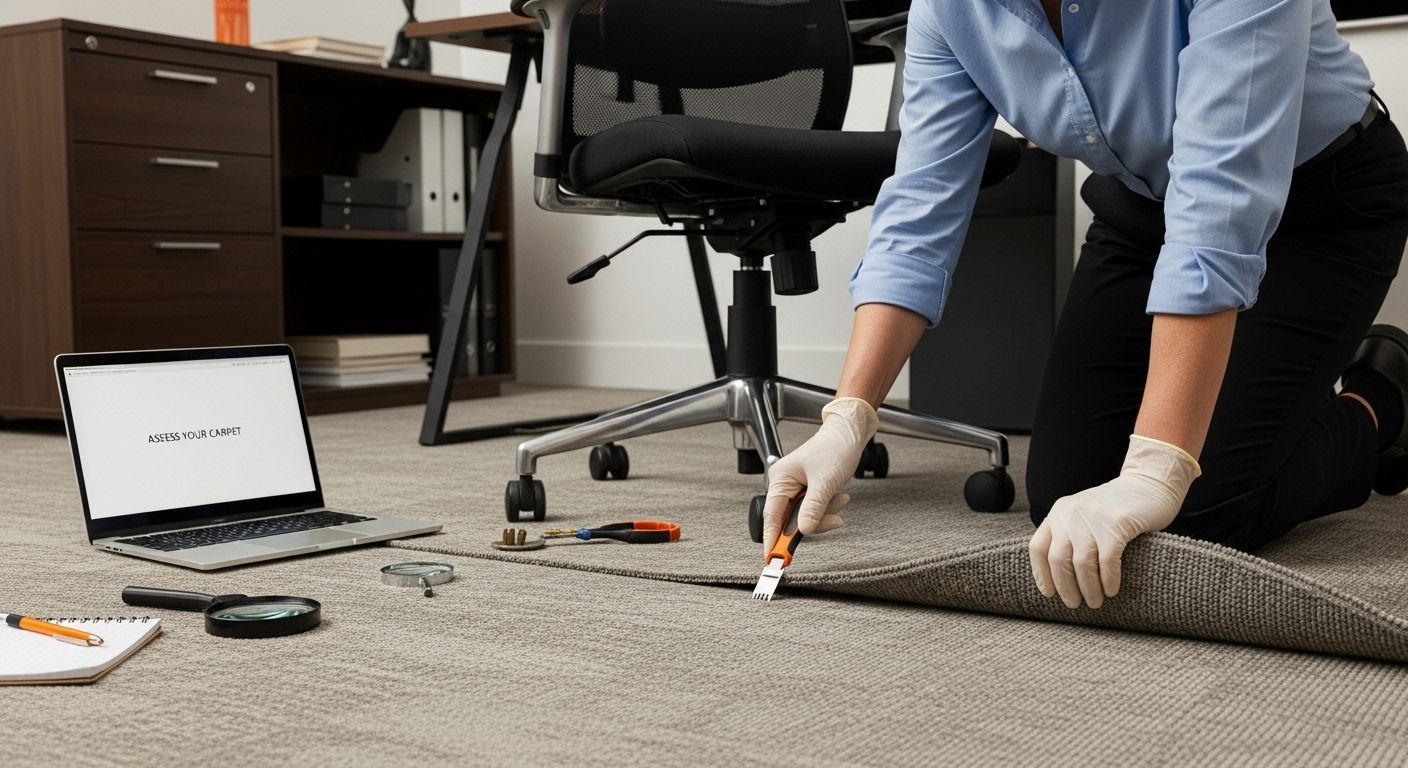
Office carpets might seem tough enough to survive endless chair movements, but the reality is more surprising. Some commercial carpets start showing visible chair damage in as little as six months without protection. Most people think any mat will do the job, only to find that using the wrong solution can speed up wear and leave carpets looking tired far too soon. Understanding what really protects your carpet can make all the difference between costly replacements and a workspace that stays pristine.
Table of Contents
- Step 1: Assess Your Carpet Type And Condition
- Step 2: Choose The Appropriate Protective Solution
- Step 3: Prepare The Area For Installation
- Step 4: Install The Chosen Protection Method
- Step 5: Test For Effectiveness And Make Adjustments
Quick Summary
| Key Point | Explanation |
|---|---|
| 1. Assess carpet type and condition | Examine fabric, pile height, and wear patterns to determine the best protective strategy for your carpet. |
| 2. Select suitable protective solutions | Choose chair mats or protective films based on carpet type and traffic volume to enhance durability and comfort. |
| 3. Prepare workspace meticulously | Clean carpets thoroughly and ensure a dry surface to guarantee effective installation of protective solutions. |
| 4. Install protection accurately | Position mats or films carefully, checking for bubbles or misalignment to ensure optimal coverage and performance. |
| 5. Test effectiveness after installation | Simulate chair movements to evaluate the protective solution’s stability and make adjustments as needed for continued protection. |
Step 1: Assess Your Carpet Type and Condition
Protecting your office carpet from chair damage begins with a comprehensive assessment of your carpet’s current condition and material composition. Understanding these fundamental characteristics will determine the most effective protection strategy and prevent unnecessary wear and potential long term damage.
Start by carefully examining your carpet’s fabric and construction. Commercial carpets come in various materials such as nylon, polyester, wool, and synthetic blends, each with unique durability and resilience characteristics. Nylon carpets, for instance, tend to withstand heavy office chair traffic more effectively than more delicate natural fibre options. Pay close attention to the carpet’s pile height, density, and weave pattern, as these factors significantly influence its ability to resist compression and permanent indentation from chair wheels.
Inspect the current condition of your carpet, looking for existing signs of wear such as flattened areas, visible tracks around desk spaces, and compression marks from chair movement. These indicators reveal where your carpet experiences the most stress and will help you strategically plan protection methods. Learn more about commercial mat cleaning techniques to maintain your carpet’s appearance and longevity alongside chair protection strategies.
Critical areas to evaluate include:
- Carpet pile thickness and resilience
- Existing wear patterns around workstations
- Material composition and inherent durability
- Potential vulnerability to wheel and castor damage
For precise assessment, consider using a professional carpet evaluation tool or consulting with a flooring specialist who can provide detailed insights into your specific carpet’s characteristics. This initial diagnostic step is crucial, as it will inform subsequent protection strategies and help you select the most appropriate solutions to prevent office chair related carpet damage.
Remember that different carpet types require tailored protection approaches. A wool carpet might need gentler interventions compared to a robust commercial-grade synthetic carpet. Your careful assessment now will save significant replacement and repair costs in the future.
Step 2: Choose the Appropriate Protective Solution
Selecting the right protective solution for your office carpet requires careful consideration of multiple factors beyond simple chair mat selection. Your chosen protective method must balance functionality, aesthetic appeal, and long term carpet preservation.
Chair mats represent the primary defence against carpet damage, but not all solutions are created equal. Transparent polycarbonate mats offer near invisible protection for professional spaces, while thicker vinyl options provide robust coverage for high traffic areas. Consider the specific demands of your workspace when making your selection. Thinner mats work well on low pile carpets, whereas plush or high pile carpets require more substantial, reinforced mat solutions that prevent sinking and maintain structural integrity.
Beyond traditional chair mats, innovative alternatives like carpet protector films can provide temporary yet comprehensive coverage. These adhesive-backed protective layers create an invisible shield against wheel marks, spills, and compression damage. Explore our comprehensive commercial mat cleaning techniques to complement your protective strategy and maintain carpet longevity.
Key considerations when selecting your protective solution include:
- Material compatibility with your specific carpet type
- Expected daily chair and foot traffic volume
- Budget constraints and long term maintenance requirements
- Aesthetic integration with existing office design
For hardwearing commercial environments, consider investing in heavy duty chair mats constructed from premium polycarbonate or reinforced vinyl. These materials distribute weight more evenly, reducing concentrated pressure points that cause permanent carpet damage. Look for mats with bevelled edges to prevent tripping hazards and ensure smooth chair movement.
Remember that your protective solution should not merely defend against damage but also enhance workplace ergonomics and visual appeal. A well chosen mat can reduce employee fatigue, minimize noise from chair movement, and create a more professional workspace environment. Take time to evaluate multiple options, prioritizing quality and compatibility with your specific carpet and office requirements.
Below is a comparison table to help you choose between different protective solutions for office carpets, based on the key considerations discussed in the article.
| Protective Solution | Suitable Carpet Type | Traffic Volume | Durability | Aesthetic Integration |
|---|---|---|---|---|
| Polycarbonate Chair Mat | Low to medium pile, commercial | Medium to heavy | Very high | Nearly invisible |
| Vinyl Chair Mat | Low pile, moderate wear | Medium | High | Slightly visible |
| Reinforced Vinyl Mat | Plush/high pile, heavy use | Heavy | Very high | Visible |
| Carpet Protector Film | Most types, temporary cover | Varies | Moderate (short term) | Invisible |
| Castor Cups/Wheel Stoppers | Any, complement to mats/films | Localised | High | Discreet/hidden |
Step 3: Prepare the Area for Installation
Preparing your workspace for carpet protection requires meticulous attention to detail and a systematic approach. Proper preparation is the foundation of successful carpet preservation, ensuring that your protective solutions integrate seamlessly and provide maximum effectiveness.
Begin by thoroughly cleaning the carpet area, removing all furniture and office equipment to create a clear workspace. Vacuum the carpet comprehensively, paying extra attention to areas with existing wheel tracks and compression marks. Use a commercial grade vacuum with strong suction to extract deeply embedded dirt and debris that could interfere with mat or protective film adhesion. This initial cleaning step is crucial, as any residual dust or small particles can compromise the installation of your protective solution.
Next, inspect the carpet surface for any existing damage, uneven areas, or slight imperfections. Minor carpet irregularities can significantly impact the performance of chair mats and protective films. If you discover significant surface inconsistencies, consider using a carpet levelling compound or consulting a professional flooring specialist to address these issues before installation. Learn more about commercial mat cleaning techniques to ensure optimal surface preparation.
Essential preparation items you will need include:
- High powered vacuum cleaner
- Cleaning cloths or microfibre towels
- Carpet cleaning solution
- Measuring tape
- Utility knife (for precise trimming)
- Cleaning gloves
Measure your workspace precisely, accounting for all furniture placement and potential movement areas. Create a detailed diagram or sketch that maps out exact dimensions, which will help you select the most appropriate protective solutions. Take measurements multiple times to ensure accuracy, remembering that even small miscalculations can lead to improper mat fitting or incomplete carpet coverage.
Finish your preparation by ensuring the carpet surface is completely dry and free from any moisture. Moisture can create adhesion problems and potentially lead to mould or mildew development under protective mats. Allow sufficient drying time after cleaning, and use fans or dehumidifiers if necessary to create an optimal installation environment. By investing time in thorough preparation, you set the stage for effective, long lasting carpet protection that maintains both aesthetic appeal and functional integrity.
The following table summarises the essential tools and materials needed for workspace preparation before installation, alongside their purpose, as explained in the preparation step.
| Tool/Material | Purpose |
|---|---|
| High powered vacuum cleaner | Deeply clean carpet and remove embedded dirt |
| Cleaning cloths/microfibre towels | Wipe surfaces and address small debris |
| Carpet cleaning solution | Clean stubborn stains and prepare the carpet |
| Measuring tape | Measure workspace dimensions accurately |
| Utility knife | Trim mat or protective film with precision |
| Cleaning gloves | Protect hands during cleaning and installation |
Step 4: Install the Chosen Protection Method
Installing your carpet protection solution requires precision, patience, and a methodical approach. The success of your protection strategy hinges on careful and accurate installation, transforming your preliminary preparations into a robust defence against office chair damage.
Begin by positioning your chosen protective mat or film precisely within the measured workspace. For chair mats, ensure complete alignment with your desk area, leaving minimal gaps that could cause tripping hazards or unprotected carpet exposure. When using transparent polycarbonate mats, take extra care to eliminate air bubbles during placement. Gently smooth the mat from the centre outwards, using a soft cloth or squeegee to create a seamless, bubble free surface that guarantees optimal carpet protection. Explore our comprehensive commercial mat cleaning techniques to maintain your protective solution effectively.
If you are using adhesive protective films, the installation process becomes even more critical. Start by peeling back a small section of the protective backing, carefully aligning the film with your pre measured area. Work slowly, gradually removing the backing while pressing the film down firmly to prevent air pockets or misalignment. Use a utility knife with a fresh blade to trim excess material, ensuring clean, precise edges that blend seamlessly with your carpet surface.
Critical installation tools and materials include:
- Utility knife with sharp blade
- Soft cloth or squeegee
- Measuring tape
- Scissors
- Protective gloves
- Cleaning cloth
Consider using castor cups or wheel stoppers as an additional protective measure. These small accessories distribute chair weight more evenly, reducing concentrated pressure on specific carpet areas. Place them strategically beneath chair wheels to minimise direct contact and potential damage. For larger office spaces, you might need multiple protective mats or a continuous protective film to ensure comprehensive coverage.
Verify your installation by performing a final inspection. Check for any loose edges, air bubbles, or potential misalignments. Test the mat or film by rolling an office chair across its surface, observing its stability and smoothness. A well installed protective solution should feel integrated with the carpet, providing a seamless, almost invisible layer of defence that maintains both aesthetic appeal and functional workspace design.

Step 5: Test for Effectiveness and Make Adjustments
Testing your carpet protection solution is a critical final step that determines the long term success of your strategy. Comprehensive evaluation goes beyond simple visual inspection, requiring systematic assessment of how your chosen method performs under real world office conditions.
Begin by simulating typical office chair movements across your newly installed protective surface. Roll chairs of varying weights and with different wheel configurations to assess the mat or film’s stability and performance. Pay close attention to how the protection method responds to sudden movements, quick turns, and prolonged stationary positioning. Watch for signs of shifting, wrinkling, or uneven surface tension that could compromise carpet protection. Some protective solutions might require minor repositioning or additional anchoring to ensure optimal performance.
Document your observations meticulously, recording any areas of potential weakness or unexpected performance characteristics. Learn more about our commercial mat cleaning techniques to complement your ongoing maintenance strategy. Look for indicators such as edge lifting, unexpected compression, or slight movements that might suggest the need for adjustment.
Key testing and evaluation criteria include:
- Wheel movement smoothness and consistency
- Surface stability under different chair weights
- Edge alignment and potential shifting
- Visual carpet compression and potential damage
- Overall protective coverage
Consider conducting a time based assessment, monitoring the protective solution over several weeks to understand its long term performance. Some materials might initially perform well but degrade with continuous use. Check for subtle changes in the carpet underneath the protective layer, ensuring that your chosen method truly prevents compression and wheel track formation.
For comprehensive verification, periodically lift the protective mat or carefully peel back protective films to inspect the underlying carpet surface. Look for any emerging signs of wear, discolouration, or permanent indentation. Be prepared to make strategic adjustments or replace your protective solution if early signs of carpet stress become apparent. Remember that proactive monitoring and willingness to adapt your approach are key to maintaining your office carpet’s pristine condition and extending its overall lifespan.
![]()
Protect Your Office Carpet with Solutions Tailored for Your Business
It is frustrating to see your carefully maintained office carpets quickly worn down by office chair wheels or heavy furniture. From the early signs of carpet compression to the challenge of finding a protection method that truly fits your unique environment, preventing long-term damage can feel overwhelming. As the article highlighted, every carpet type and workspace comes with its own set of demands. You need more than a one-size-fits-all approach. You need solutions that fit your needs, preserve your investment, and boost your professional image.
Take control of your workspace integrity with expertly made mats, designed specifically for business settings. Every product from Mats4U is crafted to meet the highest standards for durability and practical protection. Browse our range of custom floor coverings including heavy-duty chair mats that stand up to constant use. Our made-to-measure options give you a perfect fit, whether you have low-pile or luxury carpet. Plus, our logo mats allow you to reinforce your brand with every visitor and staff member who enters.

Why wait for visible damage to occur before acting? Visit Mats4U now to explore made-to-measure solutions, order a mat tailored to your needs, or request a callback for expert recommendations. If you are ready to shield your investment and upgrade your workspace, act today for long-lasting protection and a professional finish.
Frequently Asked Questions
How can I assess my carpet type before choosing protection?
To assess your carpet type, check the material composition, pile height, and existing wear patterns. Commercial carpets can be made from nylon, polyester, wool, or blends, with each offering different durability levels.
What are the most effective protective solutions for carpet against office chairs?
Effective solutions include chair mats made from polycarbonate or vinyl, as well as adhesive carpet protector films. Each option has its benefits based on your carpet type and office traffic levels.
How should I prepare my carpet before installing a protective solution?
Prepare your carpet by thoroughly cleaning it to remove all dirt and debris. Move furniture out of the way, vacuum deeply, and inspect for any damage or irregularities that might impact the protective solution’s effectiveness.
How can I test if my carpet protection solution is effective?
To test the effectiveness of your protection, simulate typical chair movements and observe how the mat or film responds. Check for stability, smoothness of movement, and any signs of shifting or damage to the carpet beneath the protective layer.









